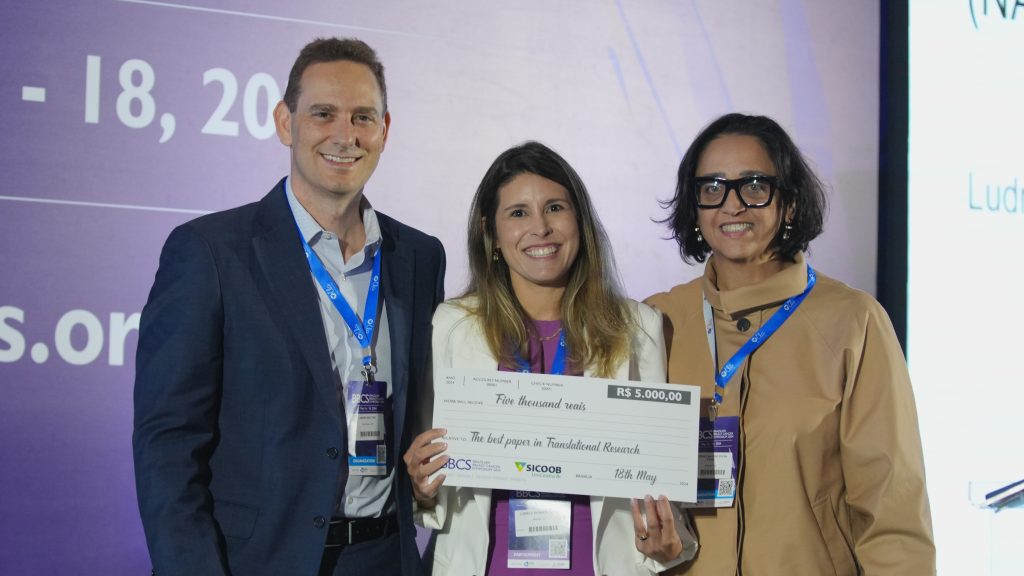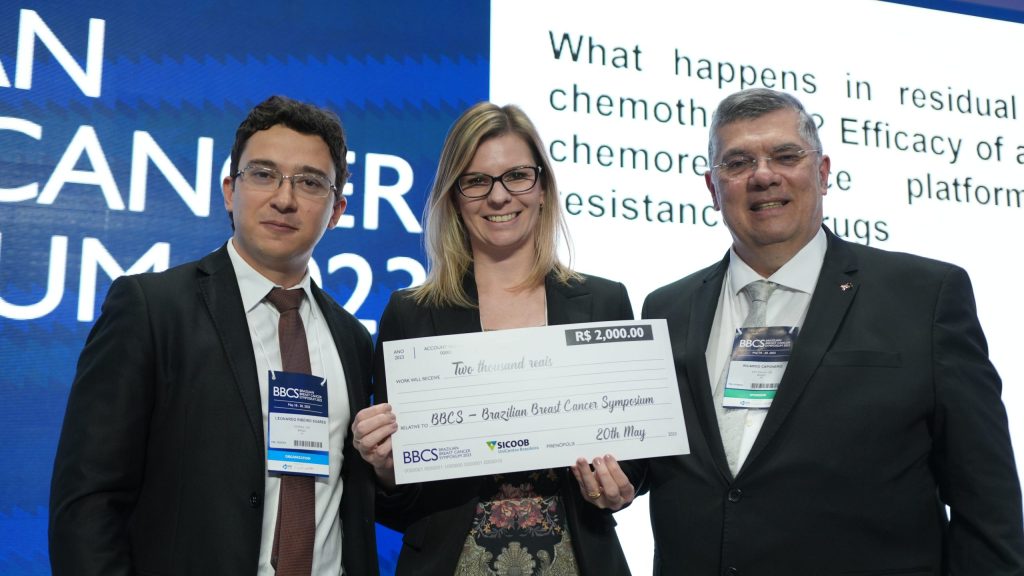
ENRICHMENT OF INTESTINAL BIFIDOBACTERIUM GENUS IS ASSOCIATED WITH RESIDUAL DISEASE AMONG PATIENTS WITH EARLY-STAGE HER2+ BREAST CANCER (BC) FOLLOWING NEOADJUVANT CHEMOTHERAPY (NACT)
Ludmila Thommen Teles1,2, Vitor Heidrich1,3, Rosângela Vieira de Andrade4, Maria Sueli Soares Felipe4, Melissa Lole Da Cas Vita5, Thiago David Alves Pinto6, Anamaria A. Camargo1,3, Romualdo Barroso de Sousa1,2.
1Health Science Graduate Program, Instituto Sírio-Libanês de Ensino e Pesquisa – São Paulo (SP), Brazil.
2DASA Oncology, Brasília Hospital, DASA, Brasília, Brazil.
3Molecular Oncology Center, Hospital Sírio-libanês – São Paulo (SP), Brazil.
4Graduate Program in Genomic Sciences and Biotechnology – UCB – Brasília (DF), Brazil.
5Sírio-Libanês Hospital, Brasília, Brazil.
6Health Science Graduate Program, University of Brasilia, Brasilia, Brazil.
Objective: The objective of this study was to characterize the gut microbiome (GM) of patients with early-stage breast cancer (eBC) who underwent NACT and to evaluate its association with clinicopathological factors and outcomes. Methodology: This was a prospective study conducted at two Brazilian Institutions. Fecal samples were collected at the baseline and prior to surgery. The GM was analyzed by 16S rRNA amplicon sequencing to characterize the α (InvSimpson indexes) and β (weighted UniFrac distance) diversity, as well the taxonomic composition. Results: Among the 55 female patients included, the median age was 49 yo, 56% had stage III disease, and 23% had used antibiotics in the prior two months before starting NACT. Regarding the immunohistochemical profile, 34.5% (n=19) of patients had estrogen receptor-positive(ER+)/HER2-negative BC, 20% (n=11) had HER2-positive disease, and 45.5% (n=25) were triple-negative. All patients with ER+ had KI 67 > 14%. There was no significant difference in alpha or beta-diversity between patients with or without pathological complete response, nor within clinical pathologic factors. The taxonomic profiling of fecal samples revealed that Lachnospiraceae at family and Blautia at genus levels were the most abundant taxon, and longitudinal samples collected during NACT showed no significant changes in GM composition. We found an enrichment for Clostridia sp. among patients who did not use antibiotic (p < 0.05, pFDR ≤ 0.25). Notably, we found a higher abundance of Bifidobacterium genus (p < 0.05, pFDR ≤ 0.25) in baseline samples from patients with HER2+ tumors who presented residual disease following NACT. Conclusion: This pilot study demonstrates the feasibility of gut microbiome sequencing in patients with eBC. We identified significant association between the relative abundance of intestinal Bifidobacterium genus response to NACT among patients with HER2+ tumors. If validated, these results can help tailor the preoperative systemic treatment of patients with HER2+ eBC.
Keywords: Breast Cancer; Neoadjuvant Chemotherapy; Gut microbiota

WHAT HAPPENS IN RESIDUAL DISEASE AFTER NEOADJUVANT CHEMOTHERAPY? EFFICACY OF A NOVEL IN VITRO BREAST CANCER CHEMORESISTANCE PLATFORM TO DEMONSTRATE HIGH RESISTANCE TO DRUGS
Martina Lichtenfels¹, Vivian Fontana², Francine Hickmann Nyland², Bianca Silva Marques², Mário Casales Schorr², Júlia Caroline Marcolin¹, Caroline Brunetto de Farias¹, José Luiz Pedrini²
¹ Ziel Biosciences|Porto Alegre|Rio Grande do Sul|Brazil
² Serviço de Mastologia do Grupo Hospitalar Conceição|Porto Alegre|Rio Grande do Sul|Brazil
Objective: Our preliminary study aims to validate the efficacy of a novel in vitro chemoresistance platform to demonstrate tumor resistance in residual disease after neoadjuvant treatment for breast cancer. Methodology: Patients with invasive BC who presented residual disease after neoadjuvant chemotherapy (NACT) were included. Fresh tumor samples were collected during surgery and dissociated to obtain the tumor cells. The tumor cells were cultured in the chemoresistance platform with doxorubicin, epirubicin, paclitaxel, docetaxel, and cyclophosphamide, and after 72h cell viability was evaluated. The test result is defined based on cell viability as low (< 40%), medium (40-60%), and high (> 60%) resistance. Results: Samples from 20 patients with residual disease after NACT were tested in the chemoresistance platform. Regarding molecular subtypes: 9 tumors were triple negative (45%), 6 Luminal (30%), 4 LuminalHER2 (20%), and 1 HER2 (5%). Sixteen (80%) patients responded partially to NACT, and four (20%) presented disease progression. Most (80%) of the patients used ACT (doxorubicin + cyclophosphamide + paclitaxel) chemotherapy regimen, 10% only paclitaxel, and 10% doxorubicin plus cyclophosphamide. The chemoresistance platform demonstrated that tumors treated with doxorubicin, paclitaxel, and cyclophosphamide in neoadjuvant setting presented high rates of resistance to the drugs (94.7% showed high resistance to paclitaxel, 58% to doxorubicin, and 52.6% to cyclophosphamide). In addition, we investigate if the tumor becomes more resistant to drugs from the same class (taxanes and adriamycin) of the treatment already used by the patients and evidenced 93.7% of high resistance to docetaxel and 50% to epirubicin. Conclusion: This preliminary finding highlighted the efficacy of the in vitro chemoresistance platform to demonstrate the acquisition of resistance during neoadjuvant chemotherapy and suggests a role of acquired resistance in the worse prognosis of patients with residual disease after NACT.
Keywords: Breast neoplasms, neoadjuvant chemotherapy, drug therapy, residual neoplasms, drug resistance